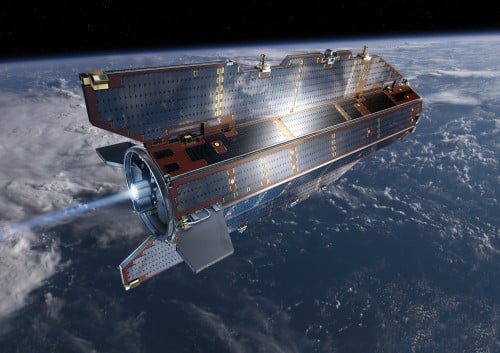Engineers from the Goce mission said that the satellite is expected to enter the Earth's atmosphere sometime during the night between Sunday and Monday, November 10-11, 2013 and disintegrate when it reaches an altitude of about 80 km. Currently, it is not possible to predict in advance the exact time and location where fragments will land," says the European Space Agency.

The updates after midnight in a new article
Update 10/11/13 23:16 - The satellite is expected to fall one to two hours earlier than the previous forecast, that is 00:30-01:30 Israel time. This was announced by the European Space Agency in its report from the last few minutes. A relay station in Antarctica that made contact with the satellite gave the data of the heat measurements on the satellite - the central computer is now set at a temperature of 54 degrees.
Update: 10/11/13 - at 14:37 GMT, the European Hala agency established contact with the Goce satellite through the ground station in Svalbard (Norway). It turns out that it was then at an altitude of 133 kilometers, and continues to descend at a rate of 1.5 kilometers per hour, however the density of the atmosphere may overwhelm the satellite within ten hours - that is, around midnight GMT or 02:30 Israel time.
We will continue to update the knowledge site on any new information.
The original news from yesterday
A satellite for the study of the ocean circulation (Goce) weighing one ton, has been orbiting the earth in an extremely low orbit since 2009 and mapping changes in gravity. However, its fuel ran out in mid-October and the satellite began its gradual descent towards Earth. Its orbit becomes lower and lower due to the influence of the atmosphere. The European Space Agency expects it to fall on Sunday or Monday.
Without fuel to direct the entry of the satellite into the atmosphere, there is no way to push or direct its fall. While most of Goce's components are expected to decay in the atmosphere, a few pieces may reach Earth's surface. Experts predict that up to 25% of the spacecraft will survive the entry into the atmosphere, including components made of advanced materials, such as composite materials containing carbon and oxygen.
Engineers from the Goce mission said that the satellite is expected to enter the Earth's atmosphere sometime during the night between Sunday and Monday, November 10-11, 2013 and disintegrate when it reaches an altitude of about 80 km. Currently, it is not possible to predict in advance the exact time and location where fragments will land," says the European Space Agency.
The Goce spacecraft was designed to fly low and spent most of its mission at an altitude of 255 km, but since then its orbit has eroded and it circled the Earth at a lower altitude than any other research satellite - 224 km. The durable structure and sleek design allowed it to remain in space for a longer time than expected, almost three times its designed life.
The data transmitted by the satellite allowed scientists to create a high-resolution map of the boundary between Earth's crust and the Sho mantle (MOHO) and to detect sound waves from the massive earthquake that struck Japan on March 11, 2011, among other things.
Heiner Klinkard, head of the European Space Agency's space debris office at the agency's control center in Darmstadt, Germany, said that when a spacecraft reaches altitudes lower than 100 km, the density of the atmosphere increases drastically. The satellite is supposed to penetrate the atmosphere at a speed of 25 thousand km/h and due to this, the pressure and the aerodynamic heating will cause the disintegration of the satellite at an altitude of about 80 km and cause a large number of fragments.
"The risk to the population on the ground will be small," Klinkard said. Statistically, you are 250 times more likely to win the German lottery jackpot than to be hit by debris from this satellite. In the 56 space flight companies, it has not happened that a man-made space fracture caused injury to humans.
In any case, all the world's space agencies will watch the satellite and update the European Space Agency's Space Debris Office, which will update the relevant safety authorities.
For the news in Universe Today
Prof. Aryeh Warshel gave a comprehensive interview to the Hidan site


2 תגובות
The satellite crashed at some point between three and four in the morning, over the Pacific Ocean (see details in the new article)
So now it is known where he will crash?
Should and when to raise your head to the sky?